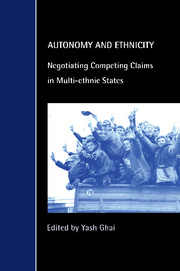Book contents
- Frontmatter
- Contents
- Acknowledgements
- List of Contributors
- 1 Ethnicity and Autonomy: A Framework for Analysis
- Part I Operating Autonomies
- 2 Federalism and Diversity in Canada
- 3 Federalism and Diversity in India
- 4 Autonomy Regimes in China: Coping with Ethnic and Economic Diversity
- 5 How the Centre Holds: Managing Claims for Regional and Ethnic Autonomy in a Democratic South Africa
- 6 Autonomous Communities and the Ethnic Settlement in Spain
- Part II Failed Autonomies
- Part III Seeking Autonomies
- List of Cases
- List of Legislation
- Index
5 - How the Centre Holds: Managing Claims for Regional and Ethnic Autonomy in a Democratic South Africa
Published online by Cambridge University Press: 06 July 2010
- Frontmatter
- Contents
- Acknowledgements
- List of Contributors
- 1 Ethnicity and Autonomy: A Framework for Analysis
- Part I Operating Autonomies
- 2 Federalism and Diversity in Canada
- 3 Federalism and Diversity in India
- 4 Autonomy Regimes in China: Coping with Ethnic and Economic Diversity
- 5 How the Centre Holds: Managing Claims for Regional and Ethnic Autonomy in a Democratic South Africa
- 6 Autonomous Communities and the Ethnic Settlement in Spain
- Part II Failed Autonomies
- Part III Seeking Autonomies
- List of Cases
- List of Legislation
- Index
Summary
Ethnic interests have shaped the quest for federalism in South Africa (Friedman 1993a; Horowitz 1991; Welsh 1993). However, federal arrangements have also been advocated by those seeking to protect non-ethnic interests. While the dominant ethnic-driven claim for federalism has provoked serious resistance, concerns about democratic accountability and effective local administration as well as regional political interests help to explain the vibrancy of the federal elements in South Africa's new 1996 constitution. I will argue that the particular constitutional outcome, which rejects particular forms of federalism while embracing a strong regionalism, is a direct consequence of both the political majority's reaction to particular ethnic claims as well as an attempt to incorporate a broader demand for the recognition of regional and ethnic diversity.
To explain this outcome, in which provincial governments wield limited powers yet provincial legislatures play a direct and constitutionally important role in the formulation and passage of national legislation in accordance with enshrined principles of cooperative government, it is necessary to understand both the history of federalist claims in South Africa and their particular role in the democratic transition and constitution-making process. In this context, it is also necessary to outline the ways in which ethnic demands have been recognised in the constitution and the alternative constitutional mechanisms which have been established to address these issues.
FEDERALISM'S SOUTH AFRICAN HISTORY
South Africa is a land of fairly pronounced regionalisms, including some historically distinctive regions – such as Namaqualand, the Western Province, the Eastern Province, the Highveld, the Eastern Transvaal, and the Northern Transvaal – which, despite their geographic, economic and even social distinctiveness, have never coincided with the historic provincial boundaries (Welsh 1994:243–4).
- Type
- Chapter
- Information
- Autonomy and EthnicityNegotiating Competing Claims in Multi-Ethnic States, pp. 99 - 121Publisher: Cambridge University PressPrint publication year: 2000
- 1
- Cited by



